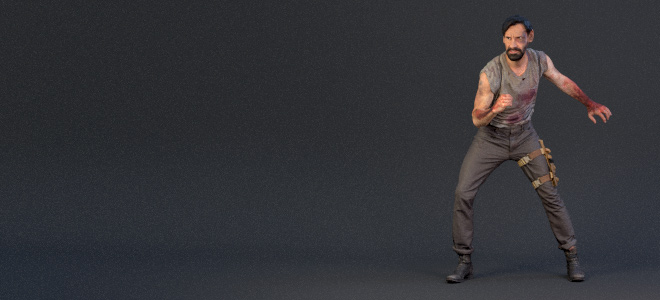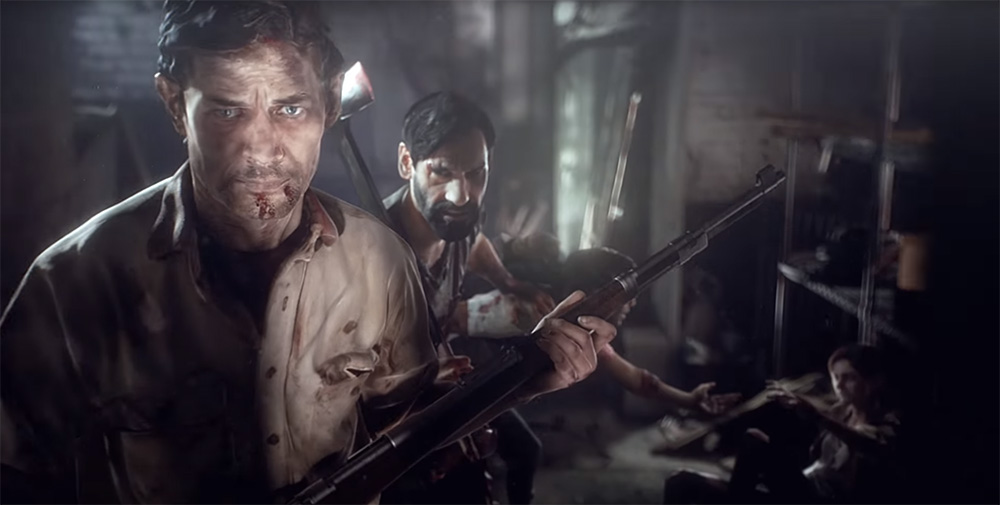Earlier this year we were asked by Psyop to help them create the 3d characters for the cinematic trailer of the new Walking Dead: No Man’s Land game by Finnish developer Next
Games. Being great fans of the series we were honored and excited to be part of it!
Mission
The idea for the 30 second trailer was to have several characters frozen in time while they are about to be overrun by a horde of zombies. To create such an effect it was crucial that each person was captured in mid-action rather than in a neutral position and be reposed later. It is not the first time we have scanned people in various poses: check out our Speed Racer scan for instance. Speed Racer and all other drivers were scanned while sitting in a skeleton cockpit to give the impression that they were racing.
“Opting for this frozen approach over something fast paced and hectic also played a large part during the technical aspects of production. Psyop and Next Games created different archetypes for each character in the trailer, and worked with Another World Studios to capture hidef 3D body scans of the four main survivors.” – Psyop
Challenge
Not all poses are equally easy to scan, if at all possible. There are certain limitations when using a structured light system like ours. Unlike with a multi-camera photogrammetry rig, you have to be able to hold the pose for at least two minutes. This means both feet have to be on the ground and the person has to be balanced. To accomplish this we had to mount a larger surface on top of our rotating platform to allow for a wider stance. Now we could scan them as if they were walking rather than standing still. The girl, who is lying on the floor with her back against the wall had to have an apple box mounted on the platform so she could sit up.

Occlusions
This is where the problems arise. We usually scan actors in an Apose (similar to the Da Vinci pose, but with the arms lowered to about 30 degrees), a position which maximizes the person’s balance and allows us to capture up to 95% of the body’s surface area, including color information. You can vary this pose slightly to accommodate clients’ preferences, but based on our experience this is the most optimal scenario. As soon as the default pose is altered, you introduce a variety of occlusions. As an example, when the person lifts up an arm so it becomes horizontal, the scanner hardly picks up any data on top or on the bottom of the arm. The camera, which is positioned at about eye level is unable to see those areas. In case of this project there were quite a few of those issues, with the girl sitting down (hiding the bottom of her legs and completely occluding her back), the other woman leaning forward hiding her stomach, etc. The scans were also done with the actors holding their stand-in props, but those did not cause too many problems.
One thing we always do whenever we have to scan a person in a different pose is do an additional 3d scan of the default A-pose. This way we have not only a backup, but we have additional data for any areas that may have been occluded in the posed scan. In case of the sitting girl we had all the data of her jeans and back of the shirt to properly fill in the gaps.
Conclusion
Every scan we have ever done had its challenges, whether they were equipment related, difficult locations or actors being hard to get a hold of. There is hardly ever a time where things go exactly as planned. I suppose this is just the nature of the industry. There is very little you can do to prepare yourself for the unexpected, like the time a TSA agent ripped out all the sensor cables from the control unit in the motorized platform or when humidity shortcircuited all your electronics. Experience however can help you out of most situations. Such was the case here, where having a wider platform and a backup scan really made the project possible. That, and a small team of highly skilled and experienced artists.
Lastly I would like to thank Pysop for giving us the opportunity to work on a project which isn’t just really cool, but also prominently features our work, whereas most of our work is usually “hidden” in fast paced action and motion blur. Be sure to read the making of the Walking Dead: No Man’s Land article on the Psyop website, and check out the video game’s homepage for updates.
